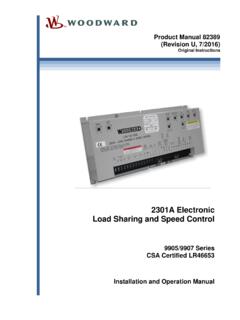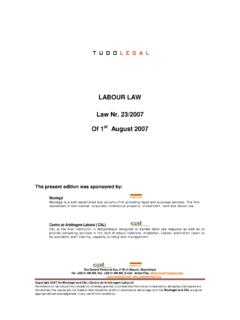Transcription of The TEACH Act
1 The TEACH Act New roles, rules and responsibilities for academic institutions A brief guide to the TEACH Act Under the TEACH Act: Signed by President George W. Bush on November 2, 2002, Instructors may use a wider range of works the Technology, Education, and copyright Harmonization in distance learning environments. ( TEACH ) Act is the product of discussion and negotiation Students may participate in distance learning among academic institutions, publishers, library sessions from virtually any location. organizations and Congress. It offers many improvements over previous regulations, specifically sections 110(2) and Participants enjoy greater latitude when it comes 112(f) of the copyright Act. The following overview of to storing, copying and digitizing materials. the TEACH Act seeks to balance the perspectives of both copyright owners and content users, and provide guidance TEACH Act requirements for today's academic institutions.
2 In exchange for unprecedented access to copyright - protected material for distance education, the TEACH . Although copyright law generally treats digital and non- Act requires that the academic institution meet specific digital copyright -protected works in a similar manner, special requirements for copyright compliance and education. digital uses, such as online distance learning and course For the full list of requirements, refer to the TEACH Act at management systems, require special attention. Some of the special copyright requirements of online distance learning are specifically addressed by the TEACH Act. In order for the use of copyrighted materials in distance education to qualify for the TEACH Act exemptions, the The TEACH Act facilitates and enables the performance and following criteria must be met: display of copyrighted materials for distance education by The institution must be an accredited, accredited, non-profit educational institutions (and some non-profit educational institution.)
3 Government entities) that meet the TEACH Act's qualifying The use must be part of mediated requirements. Its primary purpose is to balance the needs of instructional activities. distance learners and educators with the rights of copyright holders. The TEACH Act applies to distance education that The use must be limited to a specific number includes the participation of any enrolled student, on or of students enrolled in a specific class. off campus. The use must either be for live' or asynchronous class sessions. 222 Rosewood Drive + Phone 2011 copyright Clearance Center, Inc. Danvers, MA 01923 USA + Fax The use must not include the transmission of textbook Textbooks or other digital content provided under license materials, materials typically purchased or acquired by from the author, publisher, aggregator or other entity students, or works developed specifically for online uses.
4 Conversion of materials from analog to digital The institution must have developed and publicized its formats, except when the converted material is used copyright policies, specifically informing students that solely for authorized transmissions and when a digital course content may be covered by copyright , and include version of a work is unavailable or protected by a notice of copyright on the online materials. technological measures The institution must implement some technological measures to ensure compliance with these policies, It is also important to note that the TEACH Act does not beyond merely assigning a password. Ensuring supersede fair use or existing digital license agreements. compliance through technological means may include user and location authentication through Internet Protocol Ultimately, it is up to each academic institution to decide (IP) checking, content timeouts, print-disabling, cut and whether to take advantage of the new copyright exemptions paste disabling, etc.
5 Under the TEACH Act. This decision should consider both the extent of the institution's distance education programs What the TEACH Act does not allow and its ability to meet the education, compliance and technological requirements of the TEACH Act. The new exemptions under the TEACH Act specifically do not extend to: Electronic reserves, coursepacks (electronic or paper) or interlibrary loan (ILL). Commercial document delivery ACA0211. 222 Rosewood Drive + Phone Danvers, MA 01923 USA + Fax 2011 copyright Clearance Center, Inc



